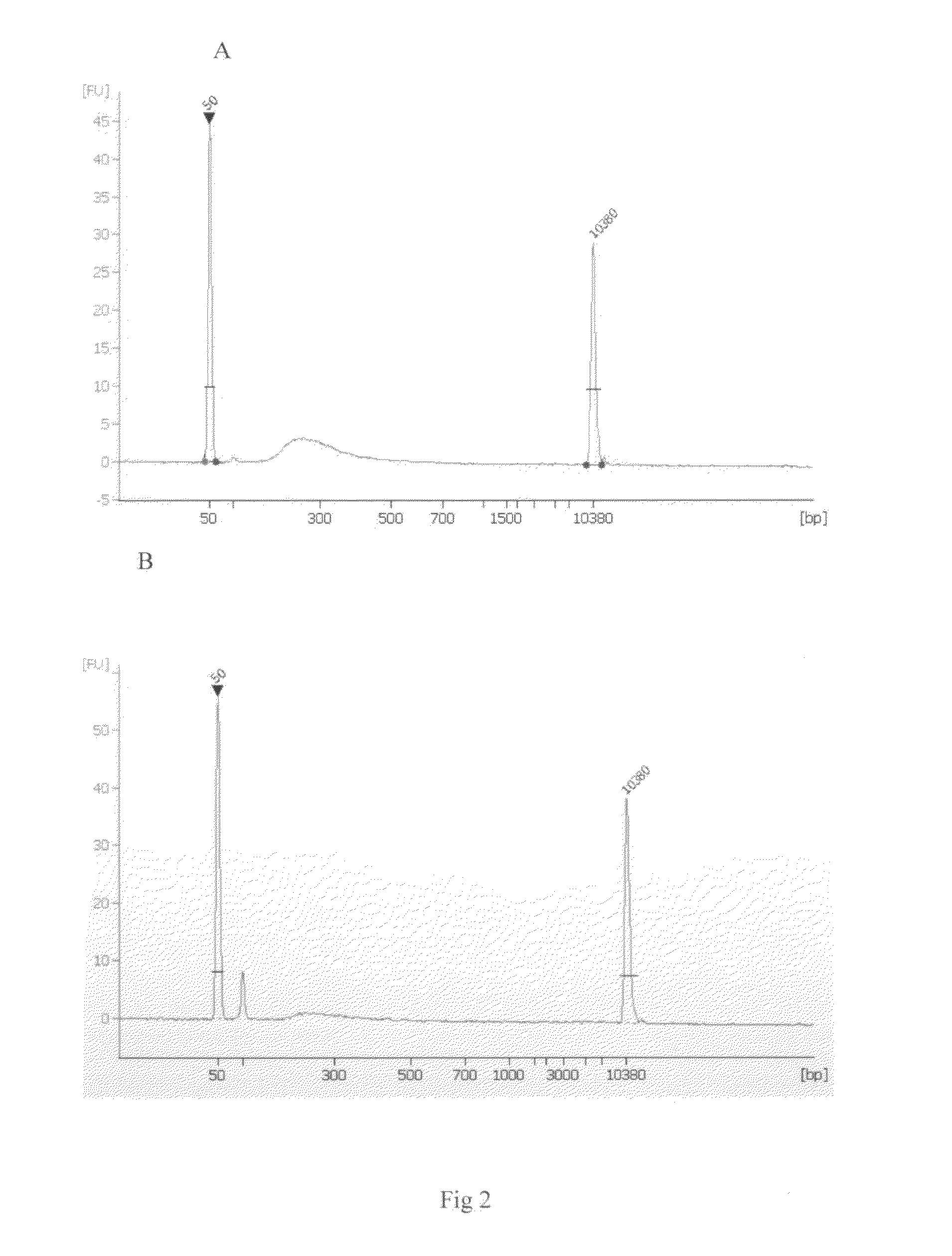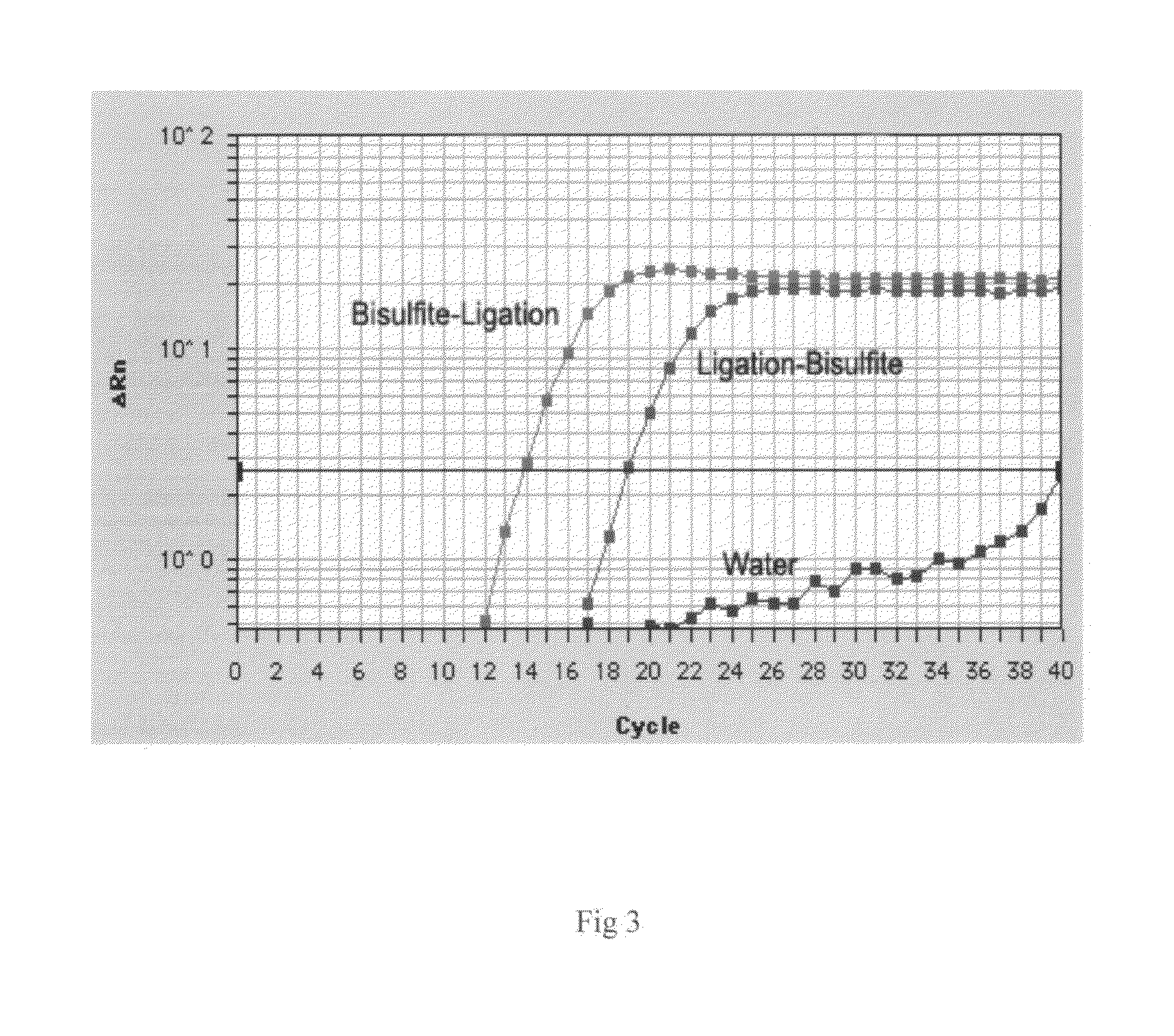Method of preparing post-bisulfite conversion DNA library
a dna library and conversion method technology, applied in the field of preparing a post-bisulfite conversion dna library, can solve the problems of difficulty in preparing such a large amount, incomplete coverage and bias, and current methods are still unsatisfactory in practical use, so as to improve sensitivity and efficiency
- Summary
- Abstract
- Description
- Claims
- Application Information
AI Technical Summary
Benefits of technology
Problems solved by technology
Method used
Image
Examples
example 1
[0024]The experiment was carried out to generate bisulfite converted DNA. Genomic DNA isolated from human placenta was treated with bisulfite reagents. The bisulfite reaction was set up as follows: DNA sample 10 μl (1 ng -1 μg), 5 M sodium bisulfite solution 120 μl (containing 0.5 M KCl), 6 M NaOH 5 μl. The reaction tubes were placed in a thermal cycler with a heated lid and run with the following program: 4 min at 95° C., 30 min at 65° C., 4 min at 95° C., 30 min at 65° C., 4 min at 95° C., 60 min at 65° C. The sample solution was then mixed with 300 μl of DNA binding buffer and the mixture was added into a spin column, DNA bound on the column was treated with 100 μl of alkali desulphonation solution and then washed with 200 μl of 90% ethanol for twice by centrifugation at 12,000 rpm for 1 min. The DNA was then eluted in 10 μl of Tris buffer. Bisulfite treated DNA was analyzed by real time PCR (42 cycles) with use of modified DNA-specific primers and unmodified DNA-specific primers...
example 2
[0025]The experiment was carried out to generate adaptor-bisulfite DNA constructs.
[0026]1. dsDNA conversion: The bisulfite-treated DNA was converted to dsDNA through dsDNA conversion reaction in 0.2 ml PCR tube. The reaction was set up as follows: bisulfite-treated DNA (from 10 ng of input DNA) 10 μl, 5X conversion buffer containing 10 mM dNTP 4 μl, 20 mM random primers 2 μl, Klenow DNA polymerase (5U / ul) 1 μl. Total reaction volume as adjusted to 20 ul by adding an appropriate volume of water. The reaction mix was incubated at 37° C. for 60 mM and was then purified with AMPure XP beads. 36 μl of AMPure XP beads were added into 20 μl of converted DNA solution and incubated for 10 mM. The beads were collected and rinsed by applying the solution to a magnetic field. DNA (>200 bps) was eluted by suspending the beads in Tri-EDTA buffer.
[0027]2. End repair: The converted dsDNA were treated with a mixture of enzymes to repair, blunt, and phosphorylate ends. The end-repair reaction was set...
example 3
[0031]The experiment was carried out to specifically amplify and quantify the post-bisulfite DNA library.
[0032]The size-selected DNA sample was amplified by PCR reactions. (a) The PCR reaction was set up as follows: size-selected sample 1 μl, Q5 High-Fidelity DNA Polymerase 1 U, 5X Q5 reaction buffer 4 μl, 10 mM dNTPs 0.4 A forward PCR primer 1 μl, reverse PCR primer 1 μl. Total reaction volume was adjusted to 20 μl by adding an appropriate volume of water. The following PCR protocol was used: 30 sec at 98° C., 18 cycles of 10 sec at 98° C., 15 sec at 55° C., and 20 sec at 72° C. As comparison, the DNA library prepared by ligation of placenta DNA fragments to the adaptors followed by bisulfite conversion was also amplified under the same condition described above. Size distribution of amplified libraries was analyzed using Agilent Bioanalyzer. The results are shown in FIG. 2. (b) For quantification of the post-bisulfite DNA library, the real time PCR reaction was set up as follows: ...
PUM
| Property | Measurement | Unit |
|---|---|---|
| Time | aaaaa | aaaaa |
| Time | aaaaa | aaaaa |
| Length | aaaaa | aaaaa |
Abstract
Description
Claims
Application Information
 Login to View More
Login to View More - R&D
- Intellectual Property
- Life Sciences
- Materials
- Tech Scout
- Unparalleled Data Quality
- Higher Quality Content
- 60% Fewer Hallucinations
Browse by: Latest US Patents, China's latest patents, Technical Efficacy Thesaurus, Application Domain, Technology Topic, Popular Technical Reports.
© 2025 PatSnap. All rights reserved.Legal|Privacy policy|Modern Slavery Act Transparency Statement|Sitemap|About US| Contact US: help@patsnap.com



